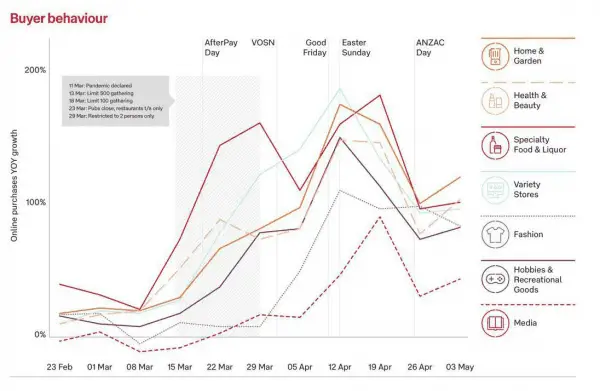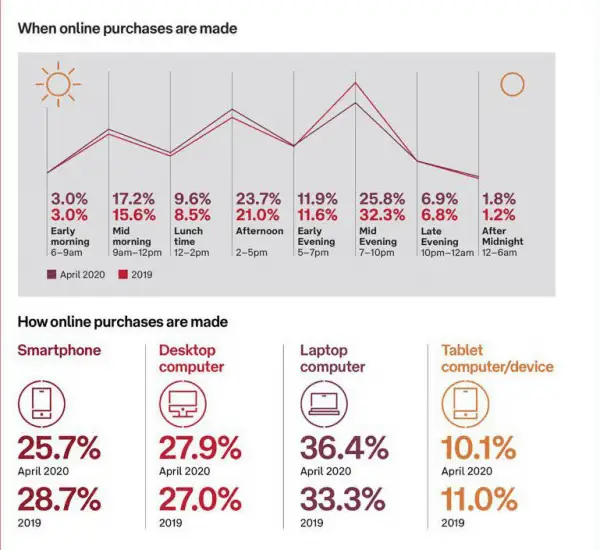Impact of COVID-19 on the e-commerce sector
According to ACI Worldwide, the company that works in the field of electronic payments, during the pandemic, the number of transactions in electronic commerce has increased. Compared to the previous year, in July 2020, the number of global transactions in e-commerce increased by 19%. During this period, the highest year-on-year increase was recorded in sales of leisure goods – 12% (9% in 2019).
The situation in Australia
As the 10th largest e-commerce market in the world, Australia has rapidly developed into an ideal place for international business expansion. E-commerce in Australia has grown significantly in recent years and turnover is expected to reach $35.2 billion by 2021.
In April 2020, more than 200,000 new customers entered the online space. Of these, more than one third (35.5 percent) have made purchases online more than once, and 16.7 percent have made purchases three or more times. The April 2020 shopping influx led to 5.2 million households making monthly online purchases, 31 percent more than the 2019 average. Consequently, spending on online goods for the same month increased by 95% compared to the same period last year.

*Data were taken from Australia Post 2020 eCommerce Industry Report
This industry-wide shift was abrupt and rapid, and undoubtedly changed the behavior of customers and significantly affected their habits. As Australians settled in their homes, online shopping increased, including items for entertainment, self-improvement, DIY, comfortable and casual clothing, and gifts for connecting with loved ones.
Demand for clothing declined in the early stages of the pandemic, when purchasing priorities were more demand-driven than desire-driven. And declined to -5% compared to the previous year. This demand soon recovered as people acclimatized to home life. Growth rates peaked at 100 percent as more active clothing and leisurewear were purchased. Despite the stabilization of the world situation, many of the changes we have seen are likely to be irreversible.
Fraud in E-commerce
The growth and development of the sector do not reduce the turnover of fraud in e-commerce. Despite the fact that the volume of fraudulent transactions in 2020 was slightly lower (by 2.3%), their value increased by 4.4% compared to 2019. E-commerce fraud attempts continue to increase due to expensive items such as electronics.
Trends in fraud:
- The transactional value of fraud attempts was 3.5% in July, due to the purchase of electronics, such as laptops, TVs and webcams.
- The average price for fraud attempts increased by 10 dollars in the period from January to July 2020 compared to the same period in 2019.
- Non-fraud refunds increased by 23 percent in June 2020 compared to June 2019.
Trends in e-commerce shopping:
- Sectors that continue to grow in spending worldwide: games (up 52 percent) and retail (up 48 percent).
- Sectors that continue decreases in spending worldwide include travel (down 16%) and ticket distribution (down 86%).
- The number of home deliveries has increased – 91% as of April 2020. This is 9% more than for the whole year 2019.
- Previously, purchases more often took place in the evening (32% in 2019 between 7 and 10 pm). Market research conducted by the Australian Post found that this was more consistent over the course of the day during April 2020.
- There was an increase in the number of purchases from laptops and computers. Shopping from laptops increased to 36% in April 2020 (33% in 2019).
- The share of credit cards used for online purchases increased from 23.9% in 2019 to 26% in April 2020.

*Data were taken from Australia Post 2020 eCommerce Industry Report
Conclusions and industry forecasts
The year 2020 was for e-commerce a year unlike any other. Expenses for buying goods for home and outdoor activities increased. This indicates that people began to care more about their leisure time and the quality (convenience) of life. The increase in home supplies suggests that Australians prefer safety, time savings, and convenient shopping. This also confirms a decrease in the use of the smartphone (25% compared to 28% in 2019) to order online. Most people choose the big screen of a desktop computer or laptop.
As we approach the end of this weird 2020, we’ll probably see the industry further away from its previous state. Retailers will be relying more on local manufacturing, rethinking their supply chains and perhaps renewing their focus on sustainability and social responsibility.
Recent statistics show that, since WHO declared the Covid-19 pandemic, growth has been more than 80% per annum. According to the Australian Postal Service for e-commerce, online spending is expected to account for 15% of the total retail market by the end of 2020.
Therefore, enterprises and businesses that have not yet developed a friendly relationship with the digital world can lose significantly. Explore options within your budget and focus on technologies that improve customer service or reduce the number of time-consuming manual tasks your team performs. This is sure to help you keep up with the times and get more value from your team.
Content provided by Natali Nesterenko,





